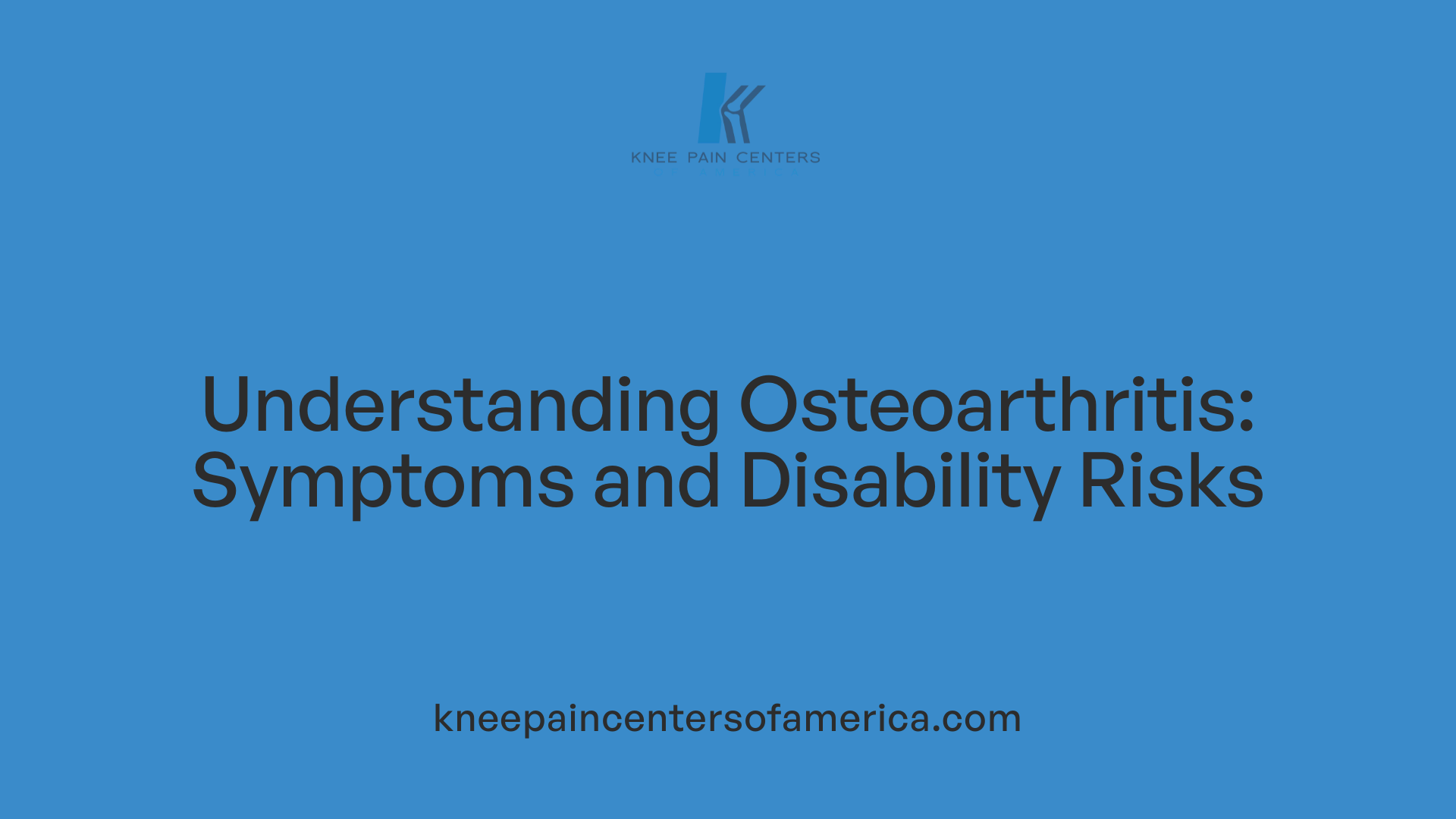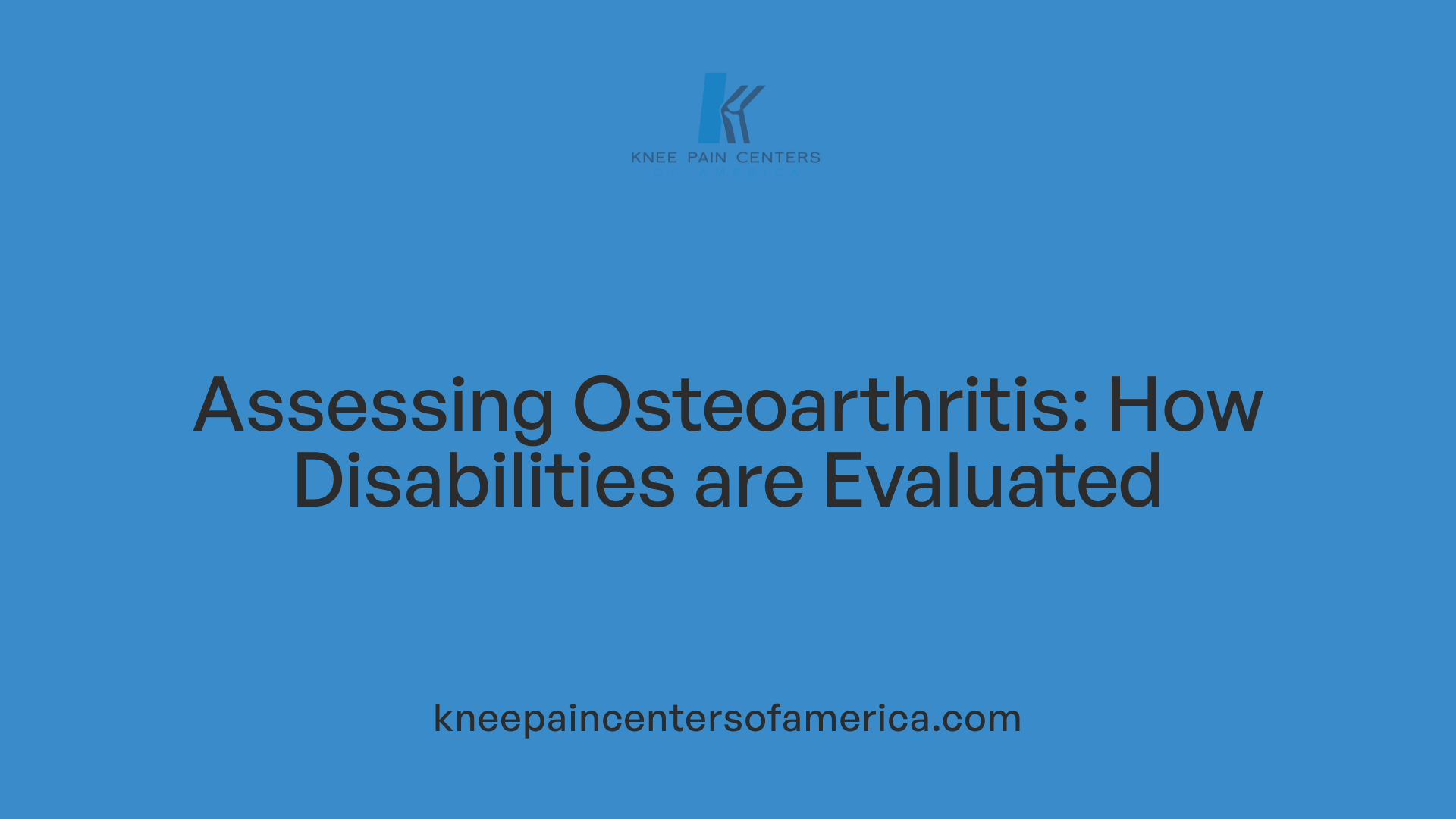Exploring the Link Between Osteoarthritis and Permanent Disability
Osteoarthritis (OA) is a common degenerative joint condition that affects millions worldwide. Characterized by pain, stiffness, and a gradual loss of joint function, osteoarthritis can significantly impair an individual's ability to perform daily activities and maintain employment. This article delves into how osteoarthritis can lead to permanent disability, examining medical symptoms, legal implications, criteria for benefits, and resources available for affected individuals.
Medical Symptoms and Implications of Osteoarthritis Leading to Disability

What are the medical symptoms and implications of osteoarthritis that could lead to disability?
Osteoarthritis manifests through a variety of symptoms, including joint pain, stiffness, swelling, and a noticeable reduction in mobility. These symptoms often begin mildly but tend to worsen gradually over time. As the disease progresses, individuals may experience persistent pain that becomes difficult to manage, along with joint deformities and decreased function.
This gradual deterioration not only impairs daily activities — like walking, bending, or grasping objects — but also affects work capabilities. People with severe osteoarthritis often find it challenging or impossible to perform physical tasks required by many jobs. In advanced cases, these limitations may meet the criteria for disability under programs like the Social Security Administration.
The impact extends beyond physical restrictions, sometimes leading to secondary issues like muscle weakness or mental health struggles such as depression. Treatments and mobility aids can help manage symptoms, but in severe stages, osteoarthritis may cause enough impairment to significantly restrict independence and employment, thus qualifying for disability benefits.
Impact on Work Capacity and Daily Living - When Osteoarthritis Becomes a Barrier

Does osteoarthritis impact work capacity and daily living, qualifying for disability?
Yes, osteoarthritis can cause significant limitations in both daily activities and work ability. When symptoms such as severe joint pain, stiffness, swelling, and reduced mobility become persistent, they can severely hinder an individual's capacity to perform routine tasks.
For instance, joint pain and stiffness in weight-bearing joints like the knees and hips can make walking, standing, or climbing stairs difficult. Similarly, osteoarthritis affecting the hands or wrists can impair gripping, grasping, or fine motor skills necessary for many jobs.
These functional impairments are especially impactful in physically demanding occupations, but they can also affect office-based roles if mobility or dexterity is compromised. The reduced ability to perform physical tasks or even cognitive tasks like reasoning and decision-making due to pain or fatigue can lead to missed work days or the inability to sustain gainful employment.
To qualify for disability benefits such as SSDI or SSI, individuals must submit medical evidence showing their condition prevents them from working for at least 12 months. This includes detailed diagnosis reports, imaging results like X-rays or MRIs, treatment records, and assessments of how symptoms limit daily and work activities.
The severity of osteoarthritis's impact depends on factors like joint involvement, disease progression, and response to treatment. Cases with advanced joint deformity, loss of motion, or need for mobility aids are more likely to meet the criteria for disability.
In summary, when osteoarthritis causes substantial impairment to daily living and work performance, it can fulfill the standards set by SSA and ADA for disability recognition. Proper documentation and medical evaluation are essential in establishing this link and securing necessary support.
Is Osteoarthritis a Permanent Disability? Medical and Legal Perspectives

Is osteoarthritis considered a permanent disability?
Osteoarthritis can be classified as a permanent disability when it causes significant and lasting limitations in a person's ability to perform daily activities and work tasks. This often happens in severe cases where joint damage leads to ongoing pain, stiffness, and decreased mobility.
According to the Social Security Administration (SSA), certain forms of osteoarthritis—especially when they involve joints like the knees, hips, or spine—may meet the criteria for disability if they produce objective evidence of substantial impairment. The condition must be demonstrated through medical records showing joint deformity, loss of motion, or joint destruction.
The progression of osteoarthritis is typically irreversible; thus, if the disease has reached an advanced stage with persistent symptoms and functional limitations, it is more likely to be regarded as a long-term or permanent disability. Factors such as response to treatments, ongoing symptoms, and functional impairment influence this determination.
Role of medical documentation and SSA evaluations
Medical records are essential in establishing whether osteoarthritis qualifies as a permanent disability. These include diagnostic imaging, doctor's notes, treatment history, and assessments of how symptoms interfere with daily routines and employment.
SSA evaluations focus on both the severity of joint damage and the impact on work ability. They employ specific listings such as Section 1.02 for joint dysfunction and Section 1.04 for spine disorders. Evidence of joint deformity, nerve root compression, or inability to ambulate significantly supports a claim.
When an applicant’s condition does not meet the criteria of a listed impairment, Residual Functional Capacity (RFC) assessments are used. These evaluate the individual's capacity to perform work despite limitations. A comprehensive medical opinion demonstrating the persistent nature of the symptoms strengthens the case for permanency.
Chronic pain as a qualifying factor
Chronic pain resulting from osteoarthritis is a major factor in disability determination. Pain that is severe, persistent, and limits movement or physical function can qualify a person for benefits, especially if well-documented through medical evaluations.
Although pain alone isn't enough, when it is coupled with objective findings—such as joint deformity, inflammation, or mobility restrictions—it fortifies the claim. Ongoing pain that prevents work or routine activities underscores the likelihood of a long-term disability.
In sum, osteoarthritis can be considered a permanent disability under SSA rules if it causes enduring and significant impairments demonstrated by thorough medical evidence. The severity and progression of the disease are crucial in determining eligibility for long-term disability benefits.
Classifying and Assessing Osteoarthritis for Disability Claims

How is the severity and functional limitation of osteoarthritis assessed?
The evaluation of osteoarthritis for disability purposes centers on how much the condition limits an individual's ability to perform daily activities and work tasks. Medical professionals review detailed records, including imaging reports like X-rays or MRIs, and functional assessments to understand the severity of symptoms such as pain, stiffness, swelling, and loss of mobility.
The assessment considers factors like joint deformity, range of motion, and presence of assistive devices. As symptoms worsen, they may impact the ability to lift, walk, stand for long periods, or perform fine motor tasks, which are all critical for work and daily life.
How does the SSA evaluate osteoarthritis using listing criteria and residual functional capacity?
The Social Security Administration (SSA) assesses osteoarthritis under specific listings, such as Major Joint Dysfunction (1.18), or spine disorders (1.15 and 1.16) if the spine is affected. To meet these listings, medical evidence must show joint deformity, nerve root compromise, or significant spinal narrowing.
If a person’s osteoarthritis does not exactly match these listings, the SSA turns to Residual Functional Capacity (RFC) evaluations. RFC assessments analyze how symptoms physically and mentally limit the individual, helping determine whether they can do past work or any other type of work. These evaluations take into account the individual's pain levels, stiffness, and limitations in mobility or strength.
Is there a personalized approach in determining disability status?
Absolutely. Each case is unique, and the severity of osteoarthritis can vary widely. Factors like age, specific joints affected, response to treatments, and existing comorbidities are all considered.
People over 50, for example, may find it easier to qualify if their condition severely impairs their ability to work, as age can influence SSA's grid rules. On the other hand, younger individuals must demonstrate that their osteoarthritis prevents them from performing any work activity.
Ultimately, medical documentation, detailed functional reports, and consistent treatment history help craft personalized evidence supporting each claim. This comprehensive approach ensures that each individual's specific limitations are accurately reflected in the disability assessment.
Supporting Evidence and Documentation for Disability Claims
What documentation or evidence is needed to support a disability claim for osteoarthritis?
Supporting a disability claim for osteoarthritis requires thorough and well-organized medical evidence. First and foremost, diagnosis confirmation is vital, which includes medical records like X-rays, MRI scans, and other imaging reports showing joint damage, deformities, or structural abnormalities consistent with osteoarthritis. These imaging results help prove the severity and progression of the disease.
Treatment histories are equally important. Documentation should detail ongoing management efforts such as prescribed medications, physical therapy sessions, surgeries (like joint replacements), and the patient’s response to these treatments. This information demonstrates the efforts made to control symptoms and the persistent nature of the condition.
Physicians’ statements or medical opinion letters are crucial in outlining specific functional limitations caused by osteoarthritis. These should describe how symptoms like pain, stiffness, and decreased mobility impact the individual’s ability to work and perform daily activities.
In addition, evidence of the use of assistive devices (such as canes, walkers, or braces) supports claims of physical impairment. Statements from caregivers, family members, or colleagues can further corroborate the severity of the disability.
Finally, medical documentation should specify the duration of symptoms and impairment, emphasizing whether the condition is expected to last at least 12 months or is permanent. All these components collectively serve to establish the extent of functional limitations and substantiate the claim for SSDI or SSI benefits.
Criteria for Eligibility for Disability Benefits Due to Osteoarthritis
What criteria are used to determine eligibility for disability benefits due to osteoarthritis?
Eligibility for disability benefits related to osteoarthritis hinges on several important factors. First, a formal diagnosis confirmed through medical evaluation, imaging reports, or clinical assessments is necessary. The diagnosed condition must show evidence of significant symptoms like joint pain, stiffness, swelling, limited movement, and possible joint deformity.
The severity of osteoarthritis is a crucial aspect. The condition must impaired the individual’s ability to perform basic work activities, such as walking, standing, lifting, or handling objects with affected joints. This impairment must persist for at least 12 months or be expected to result in death, according to SSA guidelines.
Assessment of functional limitations is performed through medical records, treatment history, and evaluations by healthcare professionals. These assessments should illustrate how osteoarthritis hampers mobility and independence, rendering the person unable to sustain gainful employment.
Furthermore, the SSA applies specific criteria such as joint deformity, severe pain, limited range of motion, and the use of assistive devices to evaluate disability. For SSDI, applicants need sufficient work credits, whereas SSI applicants are evaluated based on income and assets. Proper documentation— including doctors' reports, imaging results, treatment records, and functional assessments—is vital for a successful claim.
In sum, proof of a medically diagnosed, severe, and disabling form of osteoarthritis that substantially limits the individual's capacity to work allows qualification for long-term disability benefits.
Legal Eligibility and Benefits—How Osteoarthritis Qualifies for Disability Support

Can osteoarthritis qualify for long-term disability or other legal benefits?
Osteoarthritis can indeed qualify for long-term disability benefits if it is severe enough to hinder an individual from maintaining employment for at least 12 months. The Social Security Administration (SSA) recognizes osteoarthritis as a potential disability when it significantly impairs mobility, causes persistent pain, joint swelling, deformity, or limits daily activities and work ability. Both primary osteoarthritis and secondary forms caused by other conditions may be eligible, provided that their severity and impact meet SSA standards.
To be approved, applicants need to provide comprehensive medical evidence that clearly demonstrates how their condition affects their capacity to perform work-related tasks. This includes detailed records of diagnostic imaging such as X-rays and MRIs, treatment histories, and assessments of functional limitations, including mobility tests. Often, collaboration with healthcare professionals and legal experts helps in presenting a compelling application.
The decision depends on several factors, including disease severity, progression, and how much it restricts employment and daily living. If the disease is deemed to prevent consistent work activity and is supported by adequate medical documentation, the applicant is more likely to qualify for benefits.
In conclusion, osteoarthritis qualifies for disability support when the impairment is severe, persistent, and demonstrably limits work ability. Proper documentation and understanding SSA criteria are crucial for a successful application. People facing such challenges should consider consulting legal and medical professionals to improve their chances of approval.
Supporting Resources and Moving Forward with Osteoarthritis-Related Disability Claims
For individuals suffering from severe osteoarthritis symptoms that impair work and daily functioning, understanding the medical and legal criteria for disability benefits is crucial. Proper documentation, early application, and working with healthcare providers or legal professionals can significantly improve the chances of obtaining support. Osteoarthritis, although a progressive and often debilitating disease, can qualify as a long-term disability under SSA guidelines when it results in persistent limitations. Recognizing the signs, securing thorough medical evidence, and navigating the application process with adequate support are key steps toward obtaining the benefits needed to manage this challenging condition and improve quality of life.
References